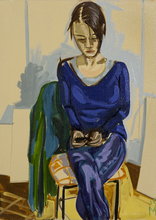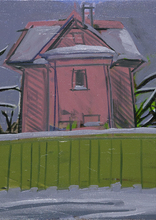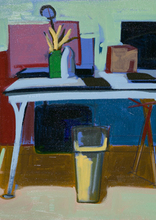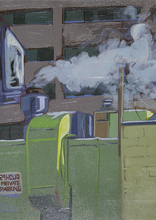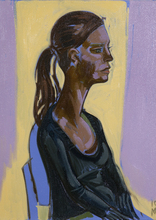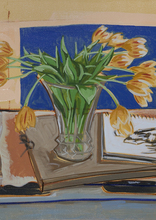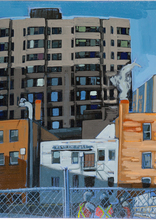Artist of the Month
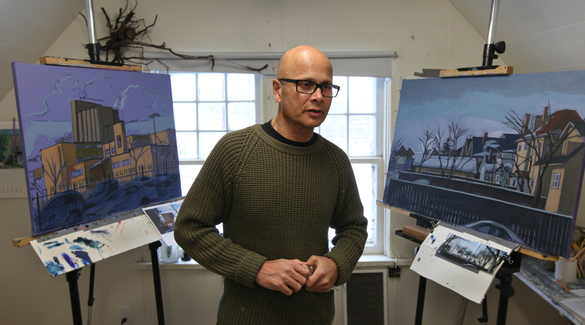
Michael Bromley in his studio, December 2012
Michael Bromley
NAC is very pleased to feature Regina painter Michael Bromley as our new Featured Artist.
Michael was born in 1955 in Darjeeling, India. After living in the Himalayas and West Bengal, he moved with his family first to England and then to Canada when he was nine years old. Settling in Moose Jaw, Michael's father was a doctor and his mother, a high school art teacher. Michael studied printmaking at the University of Regina, completing his Bachelor of Fine Arts in 1985. He then became involved with computer graphics, and has been called a pioneer in using the computer to create fine art.
Michael Bromley now works in oils on canvas. Influenced by artists such as Cezanne, Picasso, and Matisse, Michael sometimes works from photographs and tends to paint environments he is familiar with: “I paint my world; the street, out the kitchen window, the mall parking lot, a row of houses. Everything that I have seen — order, design, drama in my everyday life.” Michael has exhibited his work in Regina, Winnipeg, and Vancouver.
Below is a December 2012 interview, with more detail about Michael and his approach to artmaking.
NACmarket: Michael Bromley
Interview
How did you come to be an artist?
My mother drew and she was a high school art teacher, and so was my sister, so I come from a background of drawing and I learnt drawing as a kid. As a child I was drawing “seriously,” meaning I would just fill up a piece of paper and my mother would give me another piece of paper to fill up and she gave me tips while I was doing this. It made sense that I would go into some form of art. For a long time I did graphic art, computer art, information graphics, anything that involved design. If you have a drawing background you naturally can migrate into organizing and designing things.
How would you describe your art work today?
My present artwork is oil painting. I’ve deliberately chosen to use this medium that’s longstanding and conventionally understood. People know that it’s a major medium, and being from a graphics background, a drawing background, what I do is drawings in oil paint. That’s what they really are they — there’s lots of contour lines and drawing in them. I do flat areas and I do contours so I would say I am being a Classical post impressionist wannabe, a hundred and fifty years after the fact. But so is everybody. Classical post impressionism is the single most influential art style on representational painters: there’s movement, color, but back to form.
What artists and others have influenced you as an artist?
Well, from those genres, there’s Cezanne, Matisse, the lightness of Matisse. Picasso — I don’t work like Picasso at all but I’m inspired by his inventiveness, the audacity of the man to say ‘I’m going to do this’ and he just simply does it. And I’m trying to channel that boldness without imitating him because it would be utterly disastrous to imitate him.
How have you arrived at your particular style?
Well, I arrived at this style with a series of self imposed rules so that I could channel my drawing into an image suitable to oil paint. So my first rule is I just paint what I’ve seen. Either I’ve photograph it or it’s sitting right in front of me as I paint. My second rule is I’m not going to be fussy, I’m not going to fiddle around and do nice paintings — I want to do brutal, direct paintings. My third rule is that I want to paint fluidly and fluently without preconception. I want it to be bold, vital and alive. Also my fourth rule — I love rules — is that it has to be a product of my eye and hand working directly on a canvas. I don’t transfer an image using any mechanical device because that will kill it deader than a raccoon on the highway. That’s gonna make it sterile and dead. It has to be alive like a drawing, so I just draw with a wet brush, and just like a draftsman leaves his construction lines evident as a future reference, the construction lines are still there in my paintings.
Has living in Regina shaped you as an artist?
Oh definitely. What I paint is my immediate environment, my immediate experience. My family and I moved to the prairies and we were very impressed and influenced by the geography. This high dry plain which is a type of desert environment has a purity, has a directness that I want to paint like that. I want to draw a horizon in one sweeping brush stroke, have just a brilliant blue sky on a bitterly cold winter day. We came from India, and especially my dad and I were very sensitive to the geography of India, very excited by the National Geographic-ness of that place. So we came to another place which is the great plains of North America and were really impressed that this is as exotic and in some ways this is as wild, mostly in climate. It’s very developed in southern Saskatchewan but if you go north of the tree line it’s as wild as Bengal.
What have you found to be the best and the worst parts of being an artist?
The worst part is trying to find a market, trying to earn money, being poor, having to figure out all the business aspects. But then that’s a two edged sword because when you force yourself to do that you actually are becoming a broader person. It kind of forces your head into different ways of thinking which can only help your art. The best part of making art is when you’re making something new and original and it’s coming together, and it’s coming together in a way you hadn’t expected. You’re discovering how this is going to be. It’s a surprise to you. And the only way that works is if you repeatedly make lots and lots of oil paintings and it becomes unconscious. You see the image come up naturally on its own and you don’t work to a preconceived idea.
What are your own expectations for your work going forward? Your goals and your ideas and what lies ahead?
To keep working in more inventive ways. I want to explore new way of working, almost like a filmmaker. One of my most inspiring artists is Stanley Kubrick, the filmmaker, who started as a Life Magazine photographer and that taught him his basic aesthetic style. And I would like to look at myself as a one cel filmmaker — instead of 1/24 of a second you could stare at it for two hours if you like or you can glance it for 1/24 of a second. So you can go and look at reality and find what a reality shows you, or you can tweak it and change it and synthesize the image and arrange the shot, arrange the mise-en-scene, arrange your meaning into a little still playlet. I want to synthesize images that look completely natural, to depict what could happen and be completely dramatic, like a filmmaker would.
Michael Bromley
- Born: Darjeeling, West Bengal IN
- Resides: Regina, SK
- Genre: Cityscape, Portrait, Still Life
- Mediums: Oil Painting
Past Artists of the Month

|
Hillary RyderDecember 2017+ View Artist |

|
Kathleen SlavinNovember 2016+ View Artist |

|
Bonnie A. ConlyJune 2016+ View Artist |

|
Michael BromleyDecember 2015+ View Artist |

|
Marlessa WesolowskiNovember 2015+ View Artist |

|
Ljubica Fa-HardiOctober 2015+ View Artist |

|
Jerry JessopOctober 2015+ View Artist |

|
Eve BarbeauSeptember 2015+ View Artist |

|
Terri LemireAugust 2015+ View Artist |

|
Jason RobinsJuly 2015+ View Artist |

|
Leah DorionJune 2015+ View Artist |

|
Jessica EdwardsMay 2015+ View Artist |

|
Kristopher GrunertApril 2015+ View Artist |

|
Bronwyn SchusterMarch 2015+ View Artist |

|
Jane A. EvansMarch 2015+ View Artist |

|
Articulate InkFebruary 2015+ View Artist |
Brandi Leah HoferJanuary 2015+ View Artist |

|
Chris WikmanMarch 2014+ View Artist |

|
Michaela HoppeDecember 2013+ View Artist |
Connect With Us










